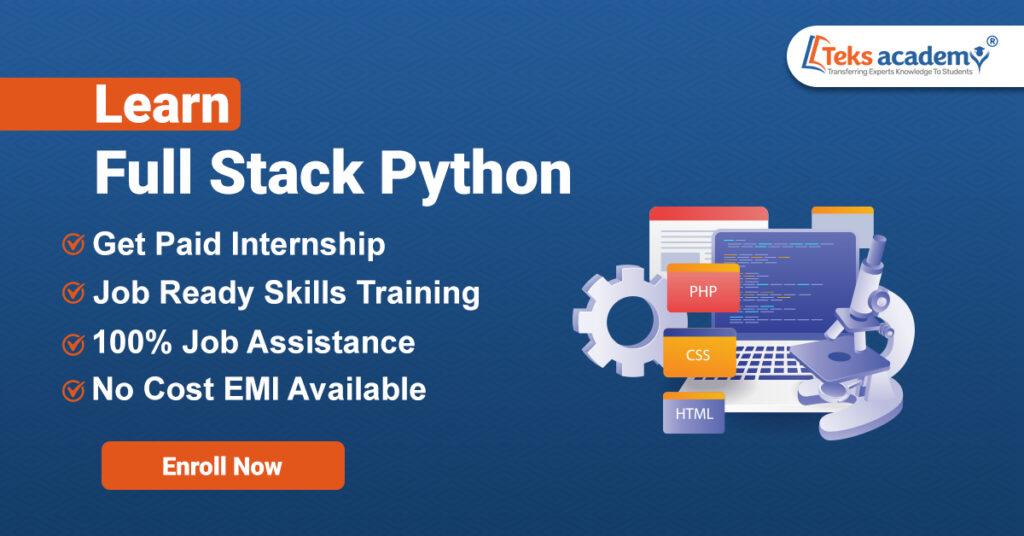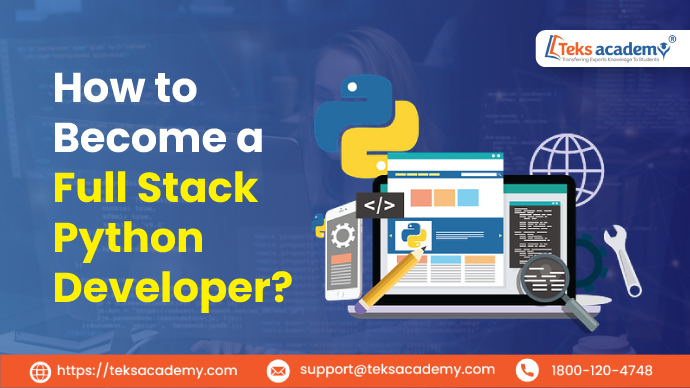When it comes to building everything in web applications, you have a bunch of programming languages to pick. Now-a-days the full-stack developers are mostly choosing easy-going languages. From that python stands first in the row. But why go for Python?
Python should be your choice because it is a high-level programming language with simple syntax, easily readable and we can write clean and concise code. That code can be very easily maintained and can handle the increased load. If your goal is to become a Full-Stack Python developer, then learn the required skills by joining in the best Python training in Hyderabad.
Who is a Full Stack Python Developer?
- Python full-stack developer is a software developer who uses Python as their main programming language for building various websites.
- They build the user interface i.e., the front end (Client-side) as well as the back end (Server-side) of the website where server logic is stored using Python.
- For front-end development, they generally use fundamental technologies like HTML, CSS, and JavaScript. Along with these they also use new technologies like React.js, Vue.js, Angular etc.
- For the back-end tasks frameworks like Django, Flask, FastAPI, Tornado and more are used.
- These developers bridge the gap between the client-side and the server-side which ensures the website is fully functional across the entire application.
Skills to become a Full Stack Python Developer in 2025
In 2025, Full Stack Python Developer is going to be in demand. To excel in this field, master the key skills by joining the top Python training in Hyderabad.
Gain Proficiency in Python Fundamentals
Before building websites from starting to finishing, you need to understand the core basics of Python. These fundamentals will help you handle all the different parts of web development smoothly. Learn the various Python frameworks and libraries that make the developing journey smooth.
- Grasp the knowledge in core concepts like data types, variables, loops, and functions.
- Practice applying these fundamentals to solve complex coding challenges and build small programs.
- A solid base in Python paves the way for learning more advanced full-stack development concepts.
Learn Front-End Technologies
As front end is a major part of the web application through which users interact. Which is also known as the user interface and deals with client-side logics.
- Master the core technologies such as HTML, CSS, and JavaScript.
- Advanced frameworks like React, Angular, Vue.js, Next.js or Bootstrap are pre-built toolkits for front-end development. These are useful as they speed up the development process as we don’t have to write the code from scratch.
- Learn to handle animations, and complex layouts to create a user experience that is not only visually attractive but also engaging and responsive.

Understand Back-End Frameworks
The back end is part of the web applications responsible for managing and handling data. It is everything that happens behind the scenes and ensures whether front-end works smoothly.
- Popular frameworks like Django, Flask, Pyramid, and CherryPy are pre-made structures for back-end development used to build robust web applications efficiently.
- Routing directs users to different pages of your application based on the URL. Models represent the real-world data, Views are responsible for presenting this data, while templates allow you to combine dynamic data with HTML for flexible content creation.
- These frameworks are designed to scale efficiently and also handles the high user traffic volumes. Additionally, learn best practices for securing your application to protect user data and prevent hacking attempts.
Explore Database Management
As Database plays a fundamental role in web applications, knowing how to work with databases is essential for building the backend of your website.
- Database management will design, implement, and maintain databases that support your application.
- Databases store all the information that your applications need in a structured format.
- Structured Query Language is a special language in database. Using this, you can write the required commands to add, edit, and retrieve data as needed.
Practice Version Control
For tracking the continuous changes made in the code, the Version Control Systems are used. Therefore, if there are any changes in the code, you could revert to the working stage. It helps in collaborating with multiple developers to work on the same project.
- Learn Git as it is the latest version control system used today. Through this you can know the regularly used commands.
- Platforms like GitHub, GitLab, or Bitbucket are online tools that have collection of codes. It eases a developer’s life as you can collaborate with your team members, manage the code, and also track changes.
- Establish a set of coding rules for your projects such as rules for code formatting, naming conventions, and commenting styles.
Continuous Integration and Deployment
Earlier software development used to take a lot of time to build, test, and deploy. But with continuous integration and deployment the build process, test process, and deploy processes work together so that bugs can be removed quickly.
- Writing the Automated Tests helps in catching the bugs earlier in the development phase.
- CI/CD Tools like Jenkins, Travis CI, or CircleCI can be integrated into your development workflow. These tools can handle continuous tasks like running automated tests, building the application, and deploying it to production servers.
- Docker and Kubernetes are used in software development to create effective containers which ensure consistency when deploying the app across different environments.
Conclusion:
Becoming a full-stack developer in Python requires a combination of skills and a determined approach. It is something that you can’t learn in a single day. Here you can gain all the necessary knowledge to become a full stack python developer. You have already taken the first step. Now it is time to make an effort and be consistent. So, start your full stack journey today and reach great heights.






